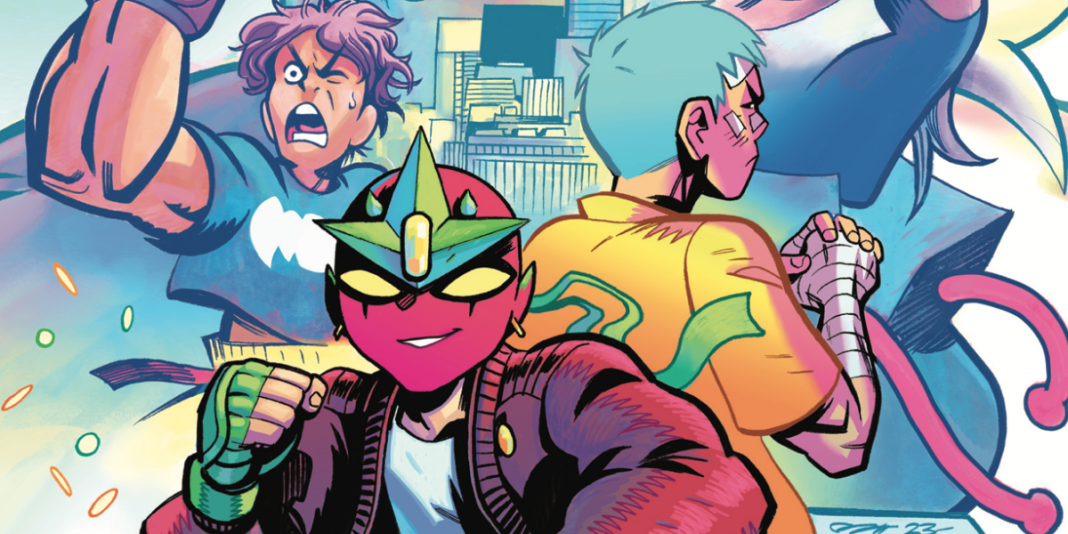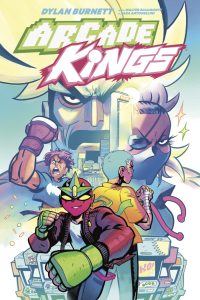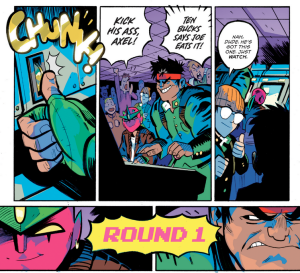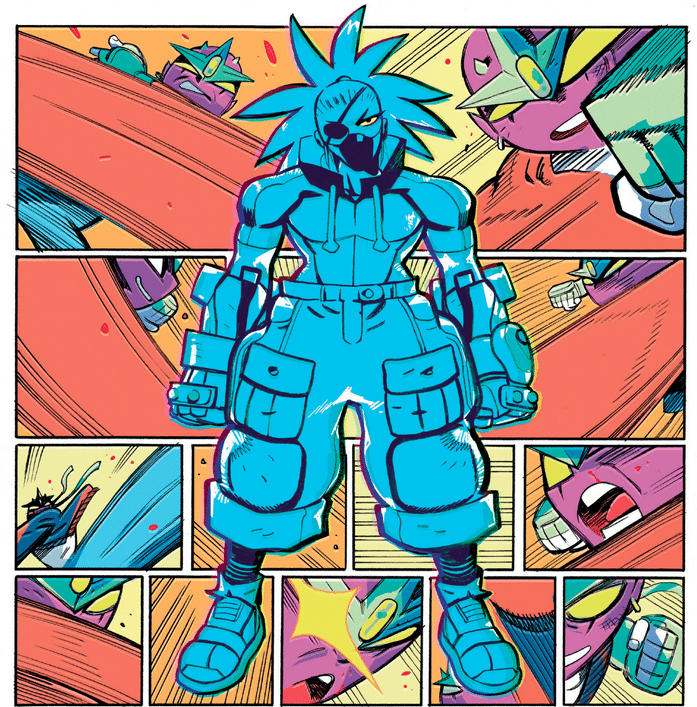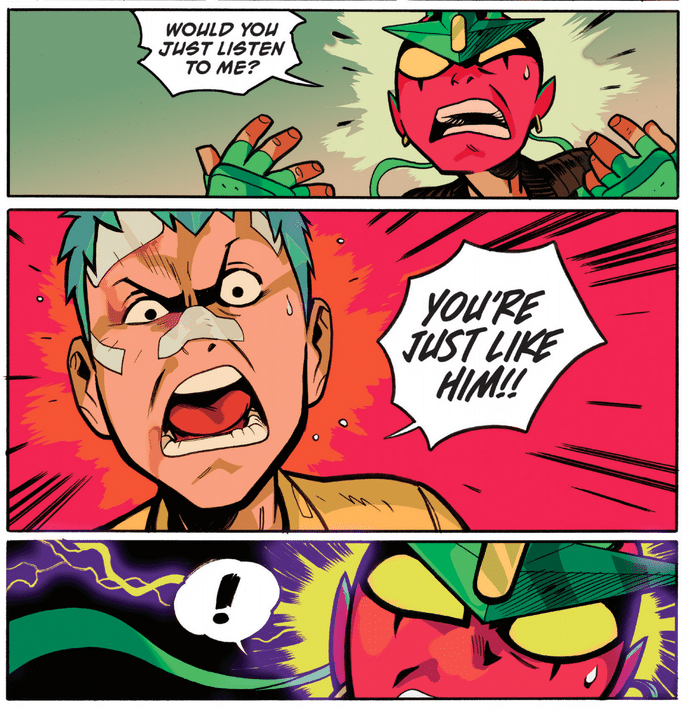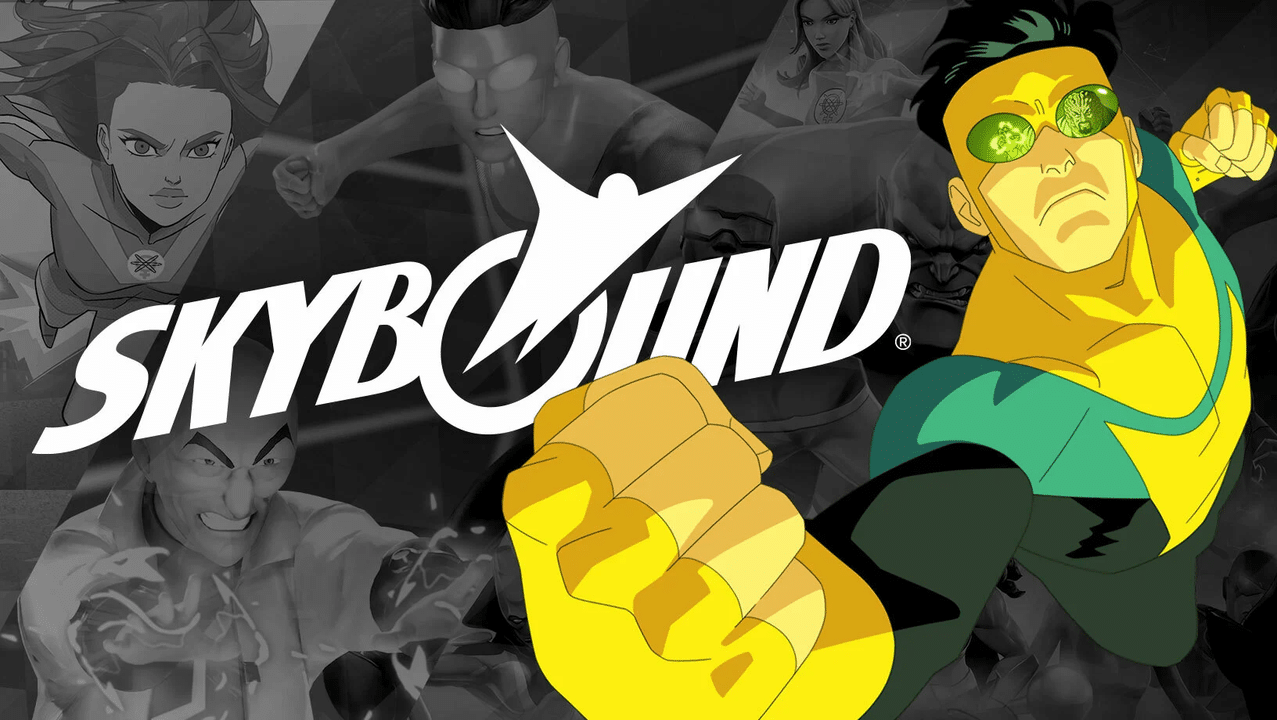Arcade Kings, Vol. 1
Writer/Artist: Dylan Burnett
Colorists: Walter Baiamonte, Sara Antonellini, Simona Iurato and Sharon Marino
Letterer: AndWorld Design
Publisher: Image Comics/Skybound
After reading Arcade Kings, I understand how people must have felt when they first read Scott Pilgrim. I wasn’t reading comics when the latter was released, so the series passed me by until long after its influence had been felt. Arcade Kings has the same anarchic and eclectic sensibility as that indie classic. Created by writer/artist Dylan Burnett, Arcade Kings’ story is not necessarily groundbreaking, but it is executed so well and with such earnestness and creativity that every page sparks with unrestrained energy. The story of fathers and sons explodes with dynamic action and some of the best fight scenes you’ll ever read in a comic book. Burnett is joined by colorists Walter Baiamonte, Sara Antonellini, Simona Iurato, and Sharon Marino, along with letterer AndWorld Design over the five issues collected in this volume. The various colorists blend seamlessly to build out a vibrant technicolor world awash in the neon glow of Arcade lights and bright visuals of 16-bit retro games.
A newcomer to Infinity City, a city owned by former wrestling superstar Vic McMax, is making waves across the Arcades scene that makes up the city’s seedy underbelly. The mysterious boy with the Dragonfruit head named Joe has made himself the de facto defender of the peace, protecting the arcades from gangsters terrorizing the neighborhood and trying to force them out of business. But the street punks are just the start of Joe’s problems as his past comes calling. It will bring him to a reckoning with his family, including his estranged brother Ken and his adoptive father, the reclusive Vic McMax himself.
Burnett’s art is full of life and motion. The anime and video game influence on his designs and characters give them an immediate familiarity. There are allusions and visual signifiers from across the history of arcade fighters that act as a kind of shortcut to understanding the characters and their roles in the story. The redhorned Joe is a hotshot cocky brawler, an unpredictable but well-meaning hero with a short temper. His brother Ken, is a reluctant fighter, with a cooler blue look. He is well dressed and hides his skills, whereas Joe flaunts his power with loud outfits and a monstrous head he can’t hide. The letters are bold, graphical explosions that perfectly extend Burnett’s visual throwback. The love for the old-school anime style shines through on every page.
Given how much this comic owes arcade-style fighters it should be no surprise that the action is spectacular. Burnett, along with AndWorld Design, adds various flourishes in the art and sound effects that draw directly from the iconography of video games. These elements like health bars and pixelated captions all work together with Burnett’s thick lines. But the book doesn’t just ape the two-dimensional sidescroller look of classic gaming combat. It’s in the language of violence that Burnett brings together all of his influences, including manga, kung fu movies, and superhero comics, into something electric and all his own. The fight scenes are not diversions but the emotional crux of the story. Burnett makes us feel the weight of these emotional conflicts between characters through the choreography and staging of his pages.
In a climactic fight between the brothers in the fourth chapter, Burnett plays with the layouts to represent the shifting power dynamics between combatants even before a single punch is thrown. At the start, Joe has the advantage visually, with his physical presence and word balloons taking up most of the page. That seeming control is interrupted by an eruption from Ken, the younger brother, that cuts across the page–complete with action lines that leave Joe reeling in the following panel, as if he was physically assaulted. From there, Ken takes control, his scowling face and anger dominating the layouts. The panels volley back and forth with closeups of each of the brothers in turn as they grapple for the upper hand, until the actual fists start flying, turning the argument into a real street fight. The small, flashing imagery of the 6-7 panel pages zips along until things erupt.
Time stops as Ken crashes his fist into Joe’s face across a full two pages. Because Burnett has staged the confrontation up until this point with some of the hallmarks of speedy manga-style action, when Ken finally unloads his anger in a physical release, we might as well be taking in the punch in slow motion. We are invited to linger on the physical weight of the blow and absorb how painful it looks.
That intentional construction of the page makes for a breezy, chaotic, and exciting read. Sure the ultimate resolution all feels somewhat inevitable but after all of the intense combat and natural character work, it is immensely satisfying. It’s that same kind of bouncing and eclectic energy that made Scott Pilgrim such a splash when it first debuted. Burnett taps into similar influences to craft something that is both homage and charmingly original. Behind all of that kinetic action is a tale of family, regret, and reconciliation. From its outlandish designs to the pastiche of visual influences, only comics could tell this story in this particular way. While this volume stands on its own as a satisfying story, I’m ready to slide another quarter into this arcade cabinet and see where round two takes these oddball street fighters.
VERDICT: BUY
Check out more trade collection and graphic novel reviews in The Beat’s review section!


